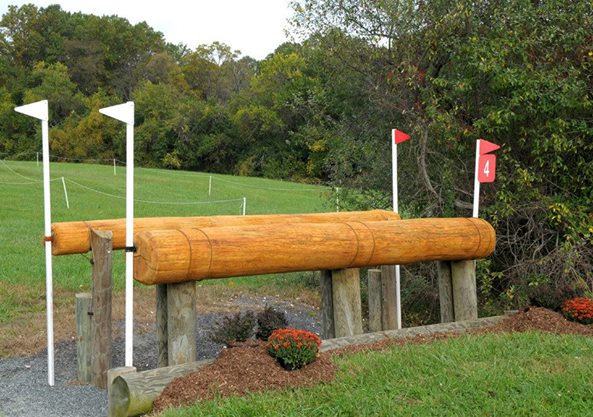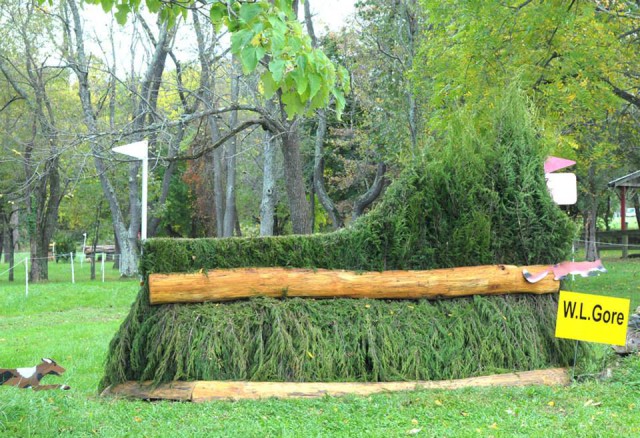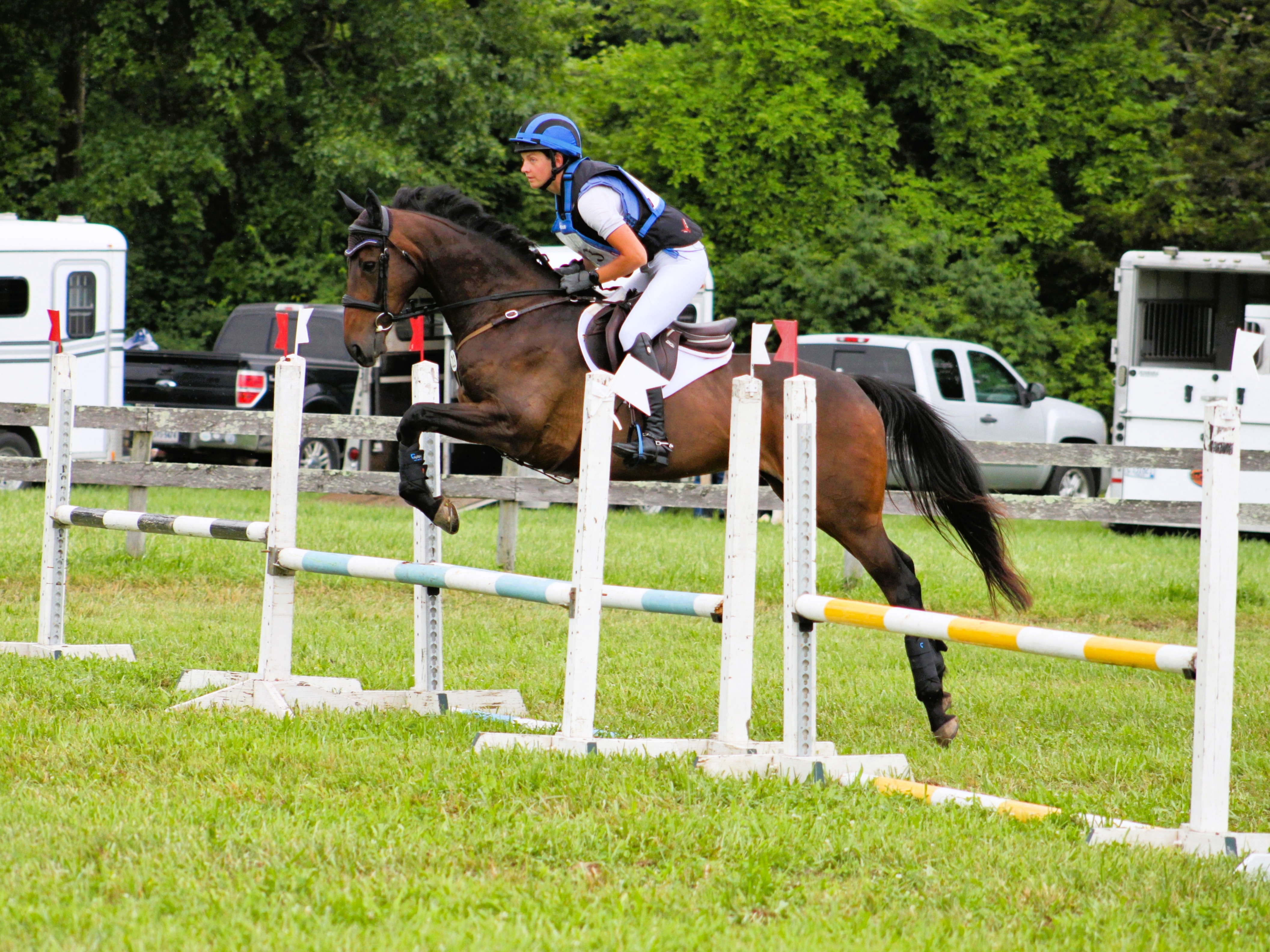
How awesome is this jump? Photo courtesy of Andrea Collins and the Fair Hill International Facebook page.
As always, the Fair Hill CCI2* is formidable, using a mix of terrain, jump placement, and clever course design to create a challenge that will require a bold, thinking rider. The footing is currently pretty spongy from a few inches of rain last night, but with no more rain in the forecast, it will hopefully dry out a bit before Saturday.
The first fence is relatively soon after the start box, situated on a bend that carries the riders into the course right off the bat. The riders can drift slightly out to jump from right to left, setting them up to continue the turn.
The second fence shows that Derek means business, a solid lavender table that allows the horses to get into a good galloping rhythm. Riders should get a good jump over this before looking for their route through the galloping lanes.
The third fence is not all that tall, but is quite wide, requiring the horses to stretch out over it. It’s also set slightly on an angle on a long stretch of straight galloping. However, it’s so wide that most riders will choose to drift to the right a little in their gallop and come at it in a bit more direct manner, perhaps with a slight left to right angle to maintain their galloping line.
By now the riders will have established a fairly good galloping rhythm and fence four will jump right out of stride.
Fence 5 is the first real test of horse and rider, situated at the top of what is a literal sunken road crossing. It’s a bit less challenging than last year’s version, which also had a B element across the road, but the width of the fence will still demand respect. After, the horses will face a sharp slope down, cross the road, then gallop up another sharp slope before resuming their way.
Instead of the daunting bank that required a leap towards the crowd that gathers near the first water crossing, Derek has instead added this brush fence next to it. While it looks simple, appearances can be deceiving; the landing is about eighteen inches below the takeoff. Riders will need to be prepared for quite a drop on the backside.
A simple hanging log begins the first combination on course, a tough water crossing that uses terrain to test the rider’s accuracy. Horses jump this log, then bend four strides to a brush fence. With a large crowd gathered, combined with the surprise water on the backside of the brush, many horses back off through here, and I’ve seen five strides snugged in here.
What you can’t see from this photo is a sharp decline in the ground directly following this fence, followed by a stride or two through the first water obstacle. As you jump this fence, you must make the decision to jump the left or right side of the corner, and stick to your plan.
To go left, the riders will hold close to the small tree (of which you can see the tip in the #7B photo), then open their right rein and pop over the corner. The right side is a bit more direct, but the line taken that way is a bit left to right, inviting run-outs.
A nice galloping fence at number eight gets the horses back into a galloping rhythm, although the addition of the steer cut-outs create an added element of excitement to a horse with an aversion to cows.
This photo of the combination in the arena shows the line the 2* riders will need to make. After jumping the large brush fence (preferably without any attempt to leap through the holes), the riders will make a bending turn to the narrow table.
After jumping the table, the horses will have a straight three stride line to the wedge.
After a tough couple of combinations, the riders will get a nice gallop stretch followed by this beautifully decorated fishy table get back into a rhythm.

Fair Hill #11A and B. Photo courtesy of Andrea Collins and the Fair Hill International Facebook page.
This fence is a perfect example of Derek’s genius when it comes to course design. Although there are no options, the brush fence is perfectly spaced to provide riders two different methods of navigating this combination. The more direct path is to jump over the center of the cabin in a forward stride, then move fairly directly towards the angled brush. The safe approach would be to collect into more of a show jumping canter, then jump the cabin on the right side, making a four stride bending line to the brush to jump it more directly.
This picnic table looks a lot larger as you walk up to it than it does in this photo. This appears to be the largest fence on the course, and while demanding the riders’ respect, should be a good fence to gallop out of stride.

Fair Hill #13A, B, and C. Photo courtesy of Andrea Collins and the Fair Hill International Facebook page.
The coffin is the next step on this course, and off a downhill approach, could be quite challenging to jump well. The bright, airy vertical will not back off many of the horses in this division, so the riders will be looking to regain a coffin canter early. The striding is a quick one and a straight two to jump the cabin on a right to left angle.
An unassuming trakehner, fence fourteen shouldn’t cause too many difficulties for the horses at this level, unless they take exception to the two-dimensional deer grazing nearby.
This log into the water is on a downhill approach around a turn, and a large crowd usually forms at this combination, as the first water crossing is on the other side of the road. The riders will need to maintain their RPMs, and come to the log with enough power to ensure both feet leave the ground.
After riding through the water, the riders will ride up a rise in the ground, then turn left to this sizable brush corner.
Next up on course is this log oxer on a long gallop. This fence will be used to re-establish the ability to jump out of stride as the pairs enter the final third of the course. At this point, some of the horses might be getting tired and the riders will need to ride accordingly.
This Weldon’s Wall has been carved into a dragon-like creature. Although the brush is impressive, at this point of the course most horses will jump it out of stride.
This combination was on course last year, or something very similar to it. The table is not too big, but the riders need to bend six strides to the B and C portions of the combination.
After bending six strides, riders need to line up the flags of two angled brush fences, set one stride apart. A gentle downhill slope adds challenge to this combination near the end of the course.
This large table is off a turn, and an approach just past the center will allow the riders to jump just a touch left to right to help to shave a few fractions of a second from their time.

Fair Hill #20A, B, and C. Photo courtesy of Andrea Collins and the Fair Hill International Facebook page.
The final combination on the course is also fairly challenging, so the riders will need to be careful not to let their guard down. A sizable brush jump to a steep slope down into the water is likely to be torn up after only a few competitors. The duck in the water is also sizable, especially for a jump in the water, and horses who back off into the water will need to be kept moving forward. After the duck, there will be three strides up the slope out of the water to the angled log.
This jump is a breather for the horses, solid enough for them to respect, but one of the smaller on the course. Up a small slope, the riders will not want to take it for granted with their tired horses.
The final two fences of the course are fairly close together, but in some ways this may make the horses and riders pay attention and really ride through the final two instead of just getting over them.
#FHI: Website, Ride Times, Live Scores, YEH Scores, Schedule, EN’s Coverage, EN’s Instagram, @eventingnation











































